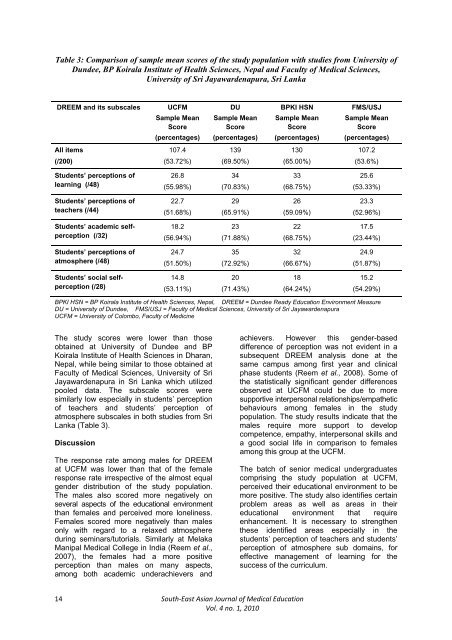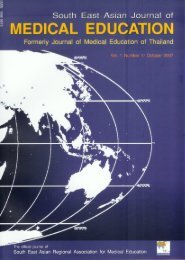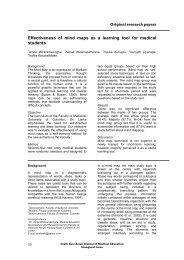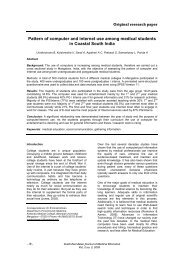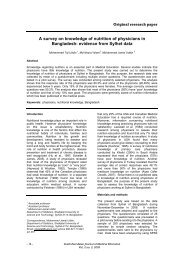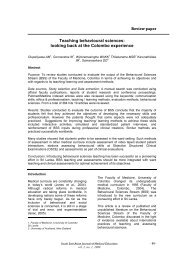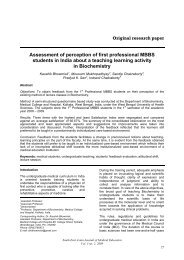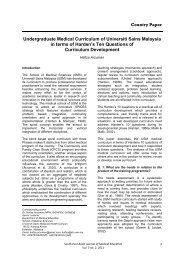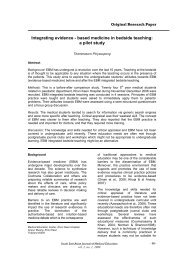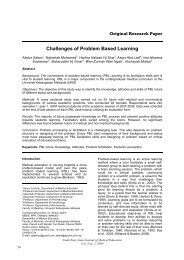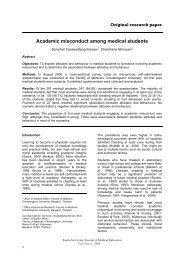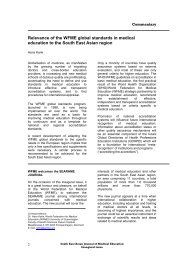Students' perception of the educational environment in a Medical ...
Students' perception of the educational environment in a Medical ...
Students' perception of the educational environment in a Medical ...
You also want an ePaper? Increase the reach of your titles
YUMPU automatically turns print PDFs into web optimized ePapers that Google loves.
Table 3: Comparison <strong>of</strong> sample mean scores <strong>of</strong> <strong>the</strong> study population with studies from University <strong>of</strong><br />
Dundee, BP Koirala Institute <strong>of</strong> Health Sciences, Nepal and Faculty <strong>of</strong> <strong>Medical</strong> Sciences,<br />
University <strong>of</strong> Sri Jayawardenapura, Sri Lanka<br />
DREEM and its subscales<br />
UCFM<br />
Sample Mean<br />
Score<br />
(percentages)<br />
DU<br />
Sample Mean<br />
Score<br />
(percentages)<br />
BPKI HSN<br />
Sample Mean<br />
Score<br />
(percentages)<br />
FMS/USJ<br />
Sample Mean<br />
Score<br />
(percentages)<br />
All items<br />
107.4<br />
139<br />
130<br />
107.2<br />
(/200)<br />
(53.72%)<br />
(69.50%)<br />
(65.00%)<br />
(53.6%)<br />
Students’ <strong>perception</strong>s <strong>of</strong><br />
learn<strong>in</strong>g (/48)<br />
26.8<br />
(55.98%)<br />
34<br />
(70.83%)<br />
33<br />
(68.75%)<br />
25.6<br />
(53.33%)<br />
Students’ <strong>perception</strong>s <strong>of</strong><br />
teachers (/44)<br />
22.7<br />
(51.68%)<br />
29<br />
(65.91%)<br />
26<br />
(59.09%)<br />
23.3<br />
(52.96%)<br />
Students’ academic self<strong>perception</strong><br />
(/32)<br />
18.2<br />
(56.94%)<br />
23<br />
(71.88%)<br />
22<br />
(68.75%)<br />
17.5<br />
(23.44%)<br />
Students’ <strong>perception</strong>s <strong>of</strong><br />
atmosphere (/48)<br />
24.7<br />
(51.50%)<br />
35<br />
(72.92%)<br />
32<br />
(66.67%)<br />
24.9<br />
(51.87%)<br />
Students’ social self<strong>perception</strong><br />
(/28)<br />
14.8<br />
(53.11%)<br />
20<br />
(71.43%)<br />
18<br />
(64.24%)<br />
15.2<br />
(54.29%)<br />
BPKI HSN = BP Koirala Institute <strong>of</strong> Health Sciences, Nepal, DREEM = Dundee Ready Education Environment Measure<br />
DU = University <strong>of</strong> Dundee, FMS/USJ = Faculty <strong>of</strong> <strong>Medical</strong> Sciences, University <strong>of</strong> Sri Jayawardenapura<br />
UCFM = University <strong>of</strong> Colombo, Faculty <strong>of</strong> Medic<strong>in</strong>e<br />
The study scores were lower than those<br />
obta<strong>in</strong>ed at University <strong>of</strong> Dundee and BP<br />
Koirala Institute <strong>of</strong> Health Sciences <strong>in</strong> Dharan,<br />
Nepal, while be<strong>in</strong>g similar to those obta<strong>in</strong>ed at<br />
Faculty <strong>of</strong> <strong>Medical</strong> Sciences, University <strong>of</strong> Sri<br />
Jayawardenapura <strong>in</strong> Sri Lanka which utilized<br />
pooled data. The subscale scores were<br />
similarly low especially <strong>in</strong> students’ <strong>perception</strong><br />
<strong>of</strong> teachers and students’ <strong>perception</strong> <strong>of</strong><br />
atmosphere subscales <strong>in</strong> both studies from Sri<br />
Lanka (Table 3).<br />
Discussion<br />
The response rate among males for DREEM<br />
at UCFM was lower than that <strong>of</strong> <strong>the</strong> female<br />
response rate irrespective <strong>of</strong> <strong>the</strong> almost equal<br />
gender distribution <strong>of</strong> <strong>the</strong> study population.<br />
The males also scored more negatively on<br />
several aspects <strong>of</strong> <strong>the</strong> <strong>educational</strong> <strong>environment</strong><br />
than females and perceived more lonel<strong>in</strong>ess.<br />
Females scored more negatively than males<br />
only with regard to a relaxed atmosphere<br />
dur<strong>in</strong>g sem<strong>in</strong>ars/tutorials. Similarly at Melaka<br />
Manipal <strong>Medical</strong> College <strong>in</strong> India (Reem et al.,<br />
2007), <strong>the</strong> females had a more positive<br />
<strong>perception</strong> than males on many aspects,<br />
among both academic underachievers and<br />
achievers. However this gender-based<br />
difference <strong>of</strong> <strong>perception</strong> was not evident <strong>in</strong> a<br />
subsequent DREEM analysis done at <strong>the</strong><br />
same campus among first year and cl<strong>in</strong>ical<br />
phase students (Reem et al., 2008). Some <strong>of</strong><br />
<strong>the</strong> statistically significant gender differences<br />
observed at UCFM could be due to more<br />
supportive <strong>in</strong>terpersonal relationships/empa<strong>the</strong>tic<br />
behaviours among females <strong>in</strong> <strong>the</strong> study<br />
population. The study results <strong>in</strong>dicate that <strong>the</strong><br />
males require more support to develop<br />
competence, empathy, <strong>in</strong>terpersonal skills and<br />
a good social life <strong>in</strong> comparison to females<br />
among this group at <strong>the</strong> UCFM.<br />
The batch <strong>of</strong> senior medical undergraduates<br />
compris<strong>in</strong>g <strong>the</strong> study population at UCFM,<br />
perceived <strong>the</strong>ir <strong>educational</strong> <strong>environment</strong> to be<br />
more positive. The study also identifies certa<strong>in</strong><br />
problem areas as well as areas <strong>in</strong> <strong>the</strong>ir<br />
<strong>educational</strong> <strong>environment</strong> that require<br />
enhancement. It is necessary to streng<strong>the</strong>n<br />
<strong>the</strong>se identified areas especially <strong>in</strong> <strong>the</strong><br />
students’ <strong>perception</strong> <strong>of</strong> teachers and students’<br />
<strong>perception</strong> <strong>of</strong> atmosphere sub doma<strong>in</strong>s, for<br />
effective management <strong>of</strong> learn<strong>in</strong>g for <strong>the</strong><br />
success <strong>of</strong> <strong>the</strong> curriculum.<br />
14 South‐East Asian Journal <strong>of</strong> <strong>Medical</strong> Education<br />
Vol. 4 no. 1, 2010


